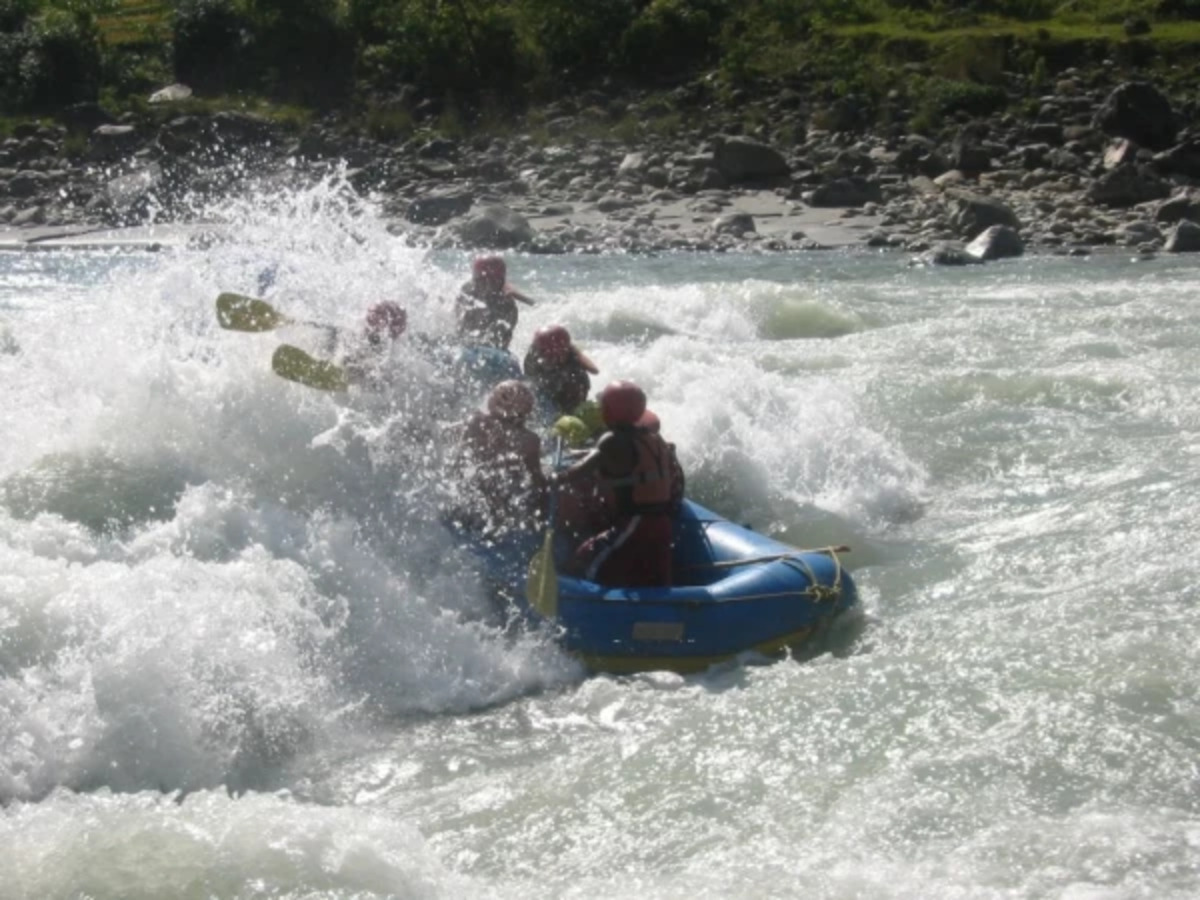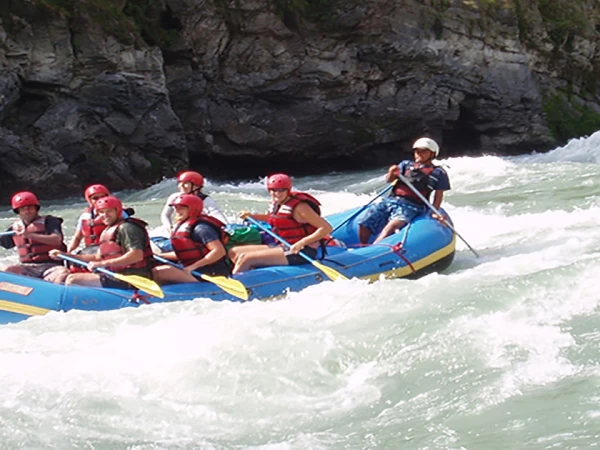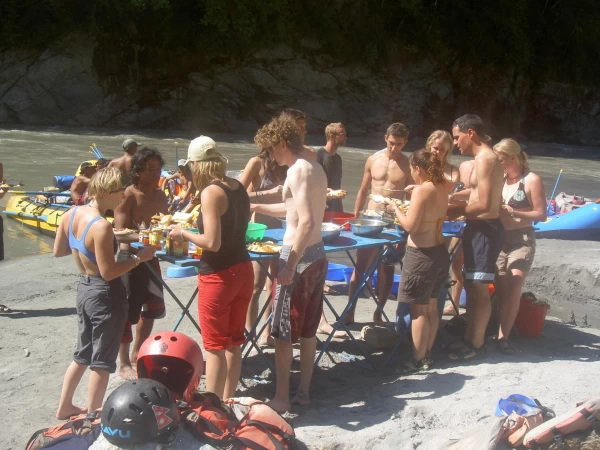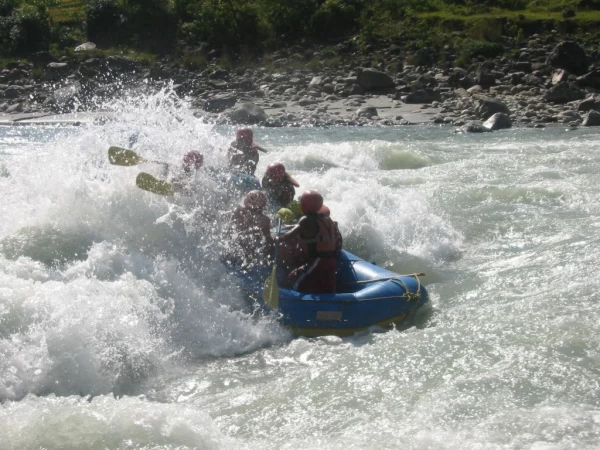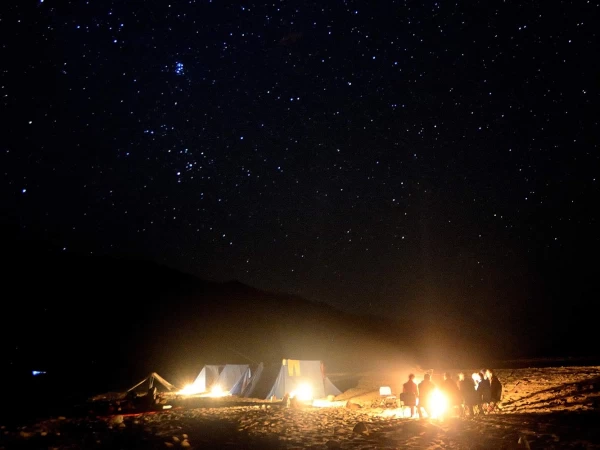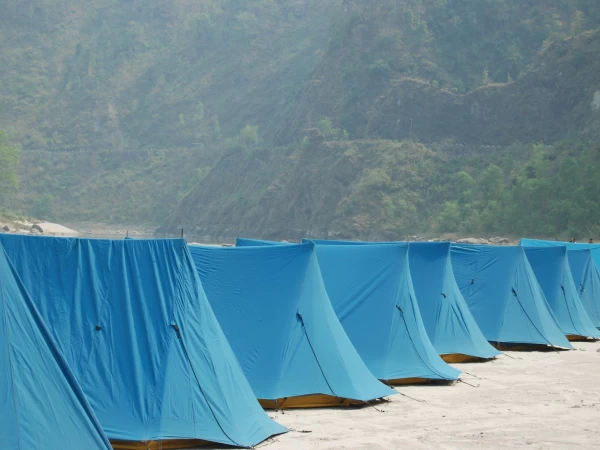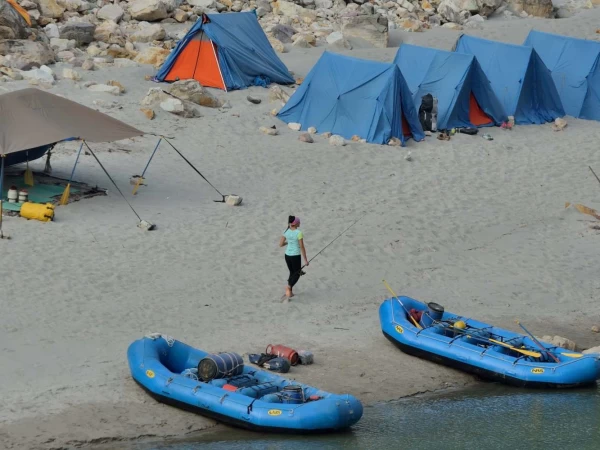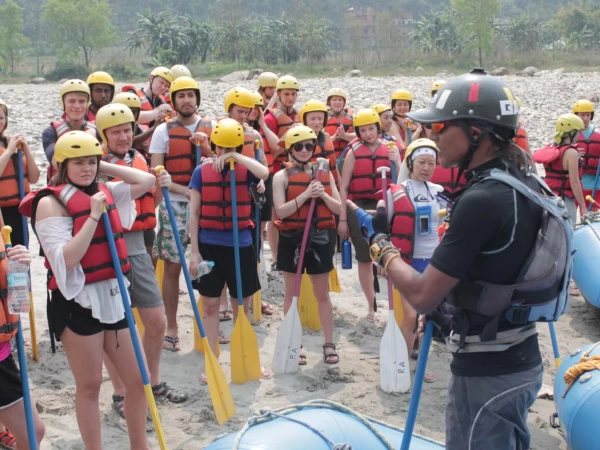Who is the Kali Gandaki River Rafting Ideal for?
The Kali Gandaki River with its Grade III to IV plus rapids makes it fit for adventurers seeking a medium to extreme rafting experience. While this expedition is mostly suitable for people who have had some rafting experience in the past, beginners with an adventurous spirit can definitely make the trip with proper guidance. Since the rapids of the Kali Gandaki vary in severity there is something for both seasoned rafters and intermediate ones looking to try extreme white water activities.
Rafting Kali Gandaki River is ideal for adventure seekers who want an adrenaline-fueled experience in the midst of breathtaking natural beauty. However, the river does call for some physical fitness and at least some minimum rafting abilities to tackle its challenging sections, especially for beginners.
You can expect a diverse rafting experience down the Kali Gandaki River depending upon your skills and the parts of the river that you choose to raft. The combination of difficult and tranquil sections of the river caters to rafters with varying abilities to enjoy the adventure while immersing in the beauty of the surroundings. Be it an experienced rafter in search of severe adrenaline pumps or a novice willing to extend your limits, the river is ideal for all.
The rafting trip in the Kali Gandaki River goes through remote villages of the indigenous inhabitants providing a rare chance to see the local culture. Also, nature lovers, bird watchers and photographers will be treated with chances of watching and clicking the rich fauna and flora of the area. Whether you are an independent traveler, a group of friends or a family looking for a safe and exciting outdoor activity, Kali Gandaki River rafting is the best choice you can make.
Planning and Preparations for Kali Gandaki Rafting Expedition
Knowing the River's Challenges
The River Kali Gandaki is renowned for having strong currents, stormy rapids and deep vertical gorges. Mental preparation in expectation of the rough waters and knowledge of the challenges you are likely to face is necessary.
In the same manner, before you start your rafting adventure, listen to your guide's words of caution. They will provide you with useful information about the rapids, flow and potential hazards of the river.

Physical Conditioning and Safety Training
It is important to assess your physical status before embarking on a Kali Gandaki rafting adventure. Rafting along this river demands reasonable physical exertion, especially in its rapid parts. Consider engaging in strength and cardiovascular workouts regularly to prepare yourself with the endurance and energy levels required for the experience.
Likewise, it is wise to get rafting safety training which typically includes learning proper paddling techniques, what to do in the event of a capsize and overall water safety procedures. If you are a beginner, a guided tour with expert professionals will fee you with the proper safety guidelines.
Right Packing
Packing the right gear is crucial for an enjoyable experience of Kali Gandaki rafting. Adequate packing with appropriate things prepares you well for a rafting trip in terms ofsafety, comfort and convenience.
Effective packing for a rafting trip involves the utilization of waterproof bags to keep your essentials dry since splashes from the river and potential capsizing are possible. Equally important is to pack your gear in orderly packs with supplies like safety gear, sun screens and spare clothing having ready and quick access.
Efficient packing also means to consider the weight and space your gear occupies as rafting excursions also mean to transport all your equipment on the raft or overnight camping on the riverbanks.
Choosing the Ideal Rafting Time
Timing your rafting trip is essential to enjoy it to the fullest. Scheduling greatly impacts your overall experience as the water level and the current's strength to the scenery of the river change accordingly to time.
If the water levels are too high, the rapids are tougher and more risky to tackle whereas too low water levels can reduce the thrill and adrenaline rush of the ride. Also, weather at different points in the year could enhance or dull the beauty of the terrain.
For the best rafting experience, parameters such as water flow for the required level of intensity, weather for convenience and sight for better enjoyment of the picturesque views is necessary to analyze. Taking into these considerations will make rafting a more delightful, safe and sight appealing experience.
Opting for a Trusted Operator
For safety and convenience, it's better to go on an organized rafting trip with a professional tour company. They will provide you with a qualified rafting guide who is experienced on the Kali Gandaki River trip.
The established operators are normally reliable and will make sure the rafting experience is enjoyable, safe and suited to your ability and skill levels.
Why is Insurance Necessary for Kali Gandaki River Rafting?
Rafting on the Kali Gandaki River has inherent risks owing to the tricky rapids and unstable river conditions. Insurance is an important consideration before going on any rafting trip and Kali Gandaki is not an exception. You will need the insurance for the following purposes during the Kali Gandaki River rafting.
Medical Emergencies
Kali Gandaki River rafting can sometimes experience capsizing, dropping from the raft or collision against rocks and other riverbed obstructions. Injury can range from minor cuts and bruises to severe ones causing broken bones, concussions or drowning.
Medical help in remote Kali Gandaki River might not be immediately accessible. However, emergency medical coverage in your insurance policy will shield you from any unfortunate happenings during your rafting trip. This usually includes ambulance fees, hospitalization, surgeries and emergency evacuation if necessary.
Helicopter rescue or transport to cities in some extraordinary situations, especially in severe accidents, and this can be costly. Adequate insurance coverage can save you from having to pay these enormous expenses.
Trip Cancellations or Delays
Events such as flight cancellations, bad weather or unforeseen personal issues can make you miss your scheduled trip. Trip cancellation or trip interruption coverage is vital in such a case.
If you have to rebook your rafting trip due to circumstances beyond your control, insurance can reimburse the non refundable fees such as your rafting booking, airfares and accommodations.
If the trip is postponed due to weather, safety or logistical reasons, you may also be covered for any expenditures incurred due to this including extra accommodations, transport or meals.
Personal Liability Protection
Accidents and damage can occur to you as well as to the people around you or property that belongs to the rafting company. Insurance will compensate in case of mistakenly damaging rafting equipment or injuring other rafting participants.
Some insurance policies have third party liability coverage which will pay the amount if you are responsible for any damages on the rafting trip without risking your finances.
Lost or Stolen Items
Rafting trips can often involve carrying personal items such as electronics, cameras, wallets and clothing. The rafting adventure in remote regions can expose your gear to the risk of getting damaged or stolen since you will be engaging in water activities and camping by the river.
Insurance is helpful to secure your property in the event of theft, loss or water damage. If your items get damaged by the river's water or get lost when there is a capsize, it will help you to be compensated for the value of such items.
Note: Aside from this, insurance provides you with confidence and peace of mind. Knowing you are protected if something happens, you can actively and completely take part in the rafting adventure without stressing day in and day out over what can happen. The cost of insurance is typically minimal when weighed against the amount of coverage it provides. The policies can also be adjusted as per the needs of the trip which can range from a basic to a comprehensive plan.

Best Time for Rafting in Kali Gandaki
The best rafting season in Kali Gandaki is largely dependent on what kind of experience you are looking for. For the most part, the dry weather and the ideal water level make March to May and October to November the excellent time to raft.
The pre-monsoon months of March, April and May provide the optimum water levels to raft, complemented by the mountain snowmelt into the stream. Rafting in this time is less bothered by heavy rain, so it is most appropriate for those in search of a more controlled experience. Likewise, nature receives a new look with flowers in bloom and dense foliage spreading across the land. The green surroundings, colorful flora and blue sky add extra beauty to the rafting experience as you float through the rapids.
Likewise, post-monsoon periods of October and November experience the stabilized flow of waters and fierce rapids of the river come to a level of safety. After the monsoons, the Kali Gandaki environment is green with dense vegetation and the weather is cooler providing for an ideal rafting experience. The visibility is perfect and the air is crisp, so it is a good time to enjoy both the thrill of the rapids and the views.
Monsoon rains in June and September can be a big factor in the flow and power of the river. The river becomes very turbulent and unpredictable during this time. Rafting should be avoided during peak monsoon as there are chances of flash floods and strong currents.
Regardless of the time of the year, it is necessary to check the weather and river conditions before getting into the river in order to have a safe and enjoyable experience. Good timing and proper preparation will allow you to achieve the best from this thrilling rafting tour.
Packing List for Kali Gandaki River Rafting
Apparel
- Quick dry T shirt, vests and trousers
- Breathable shirts and pants
- Swimwear
- Waterproof jacket and pants
- Lightweight long-sleeve shirt
- Thermal layer for winter months
- Paddling gloves
- A small towel for drying off after rafting
Footwear
- Water shoes or sandals
- Quick-drying synthetic socks
- Woolen socks to keep the feet warm
Safety Gear
- Life jacket and helmet are generally provided by the rafting operator
- Basic first aid kit: Bandages, antiseptic cream, painkillers and any medications you may require
- Whistle: Keep a whistle attached to your life jacket; it can assist in emergencies when blown.
Sun Protection
- Sun hat with a wide brim
- Waterproof sunscreen, high SPF
- SPF lip balm
- Sunglasses with a strap
Food and Hydration
- Refillable water bottle
- Energy bars, trail mix or other dry foods
Miscellaneous Items
- Insect repellent sprays
- Headlamp or flashlight for moving around campsites at night
- Personal hygiene items such as toothbrushes, toothpaste, biodegradable soap, etc.
- Ziplock bags
- Documents like visa, rafting insurance, passport and river permits
- Waterproof bags
- GoPro or camera

Safety Precautions for Rafting in Kali Gandaki River
- The Class IV+ rapids of the Kali Gandaki River necessitate quick responses and precise maneuvering to get through safely. So, before beginning, understand the difficulty level of the rapids and ensure that your skills align with the challenge.
- Wear a properly fitting life jacket which is your initial protection against capsizing or tipping into the water.
- A helmet protects your head in the event of an unexpected fall or a collision with rocks or other hazards in the river.
- A good pair of footwear such as water shoes or strap sandals will ensure avoid getting injured while treading on slippery riverbeds or rocks.
- Wear fast drying clothes that are made up of synthetic or polyester fabrics. Do not wear cotton because it soaks up water and will make you feel cold once wet.
- Listen to the safety briefing of the rafting guide. You will get to learn correct paddling techniques and emergency reaction tips from him.
- In case the raft overturns, stay calm and follow what the guide tells you. If you must swim to the nearest safety point or grab the raft, then do it.
- Heavy rains during the monsoon season can lead to sudden rises in water levels making the river unsafe. Always check the weather and river conditions before setting out on the trip.
- Clothe yourself according to the season. Cold weather: layering to avoid cold stress. Warm weather: light, dry clothing to avoid sun and to stay cool.
- In case you are suffering from any heart condition, asthma or disability, please get consulted by a doctor before taking the trip. You also need to inform your guide of any illness so proper arrangements can be made.
You May Also Like:
